Happy Wednesday!
I hope you are all enjoying your day.
I had a productive day yesterday getting my webinar, “A Neurodevelopmental Approach To Conditioning” ready for today.
I’ll be offering this as a free webinar today at 4:00 – 5:30 PST. If any of you would like to join in, you can register at www.PlaceofChi.com in Australia.
In this webinar, I’ll share how the nervous system develops and learns to move the body effectively and how disorders in infant development, or faulty exercise methods can be addressed at most any age.
This is a very important course of instruction for any and all in the exercise and health care industries.
Yesterday, I got my usual morning and evening tai-chi sessions in, which is always healing for me. I also got a lovely deadlifting session in.
Due to meeting deadlines, I wasn’t able to get into the gym until late in the afternoon.
My hormonal system is at peak performance for lifting between 10-10:30 AM, so every minute that passes after that, cortisol levels natural drop, reducing the natural stimulatory effect cortisol has on the reticular activating system.
Even so, I was able to pull 365 for four sets of 4 off the step box; you can essentially add 50 pounds to your lift from the floor relative to what you can pull off a box.
I coupled that with single arm Olympic bar rows, pulling from the fat end of the bar, and reptilian crawling. When I got home and finished my house chores and tai-chi, I did some drawing before bed.
SCIENTIFIC SHOULDER TRAINING IS HERE!
Well, after about five years in production, my new Scientific Shoulder Training correspondence course is on the press and ready to be released any moment.
This comprehensive shoulder training course comes with over 6.5 hours of DVD instruction and a 285 page (well illustrated) manual.
Holli Spicer, previously our education director, has done an excellent job on the editing and layout of the program and I’m very pleased with the finished product.
If you’d like to be notified of the pre-release special offer, feel free to go to this link and fill sign up on the notification form, which will give you quite a savings so don’t wait!
We can only give the prelaunch offer for a limited period of time and I’d love you to be able to save some money so you can enroll in an advanced training program with the CHEK Institute ☺.
What Will You Learn In This Course?
The first and most important thing you will learn from studying and applying the methods I share in this program is how to be strong for life and prevent unnecessary injuries!
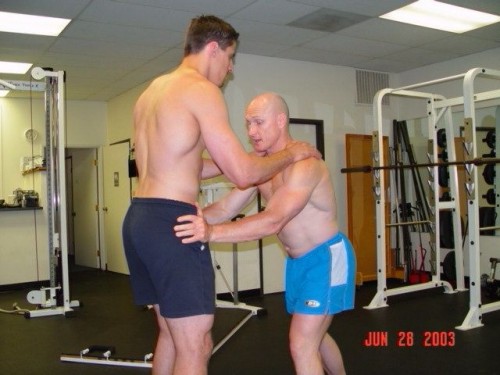
Here you can see Anthony, one of my students. Anthony is 6’8″ and 245 pounds, which you can clearly see.
He’s a Highland Games competitor and while taking an Advanced Training course with me at the institute several years ago, I challenged him to lift me over his head with all his mighty strength.
He declined so I offered to show him why I was his teacher and this is how I did it!
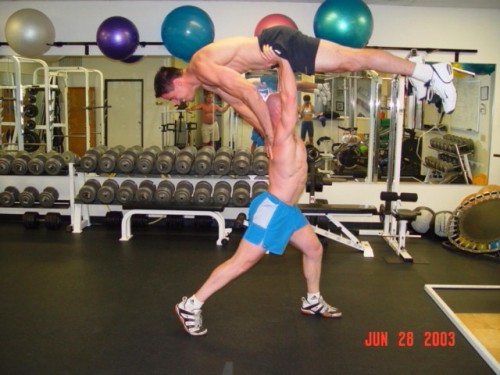
I’m not a big man, but I’ve demonstrated many times around the world that weight lifting of any type is as much about skill as it is about being strong, or using brute force.
My Sci Shoulder course will bullet proof your training program, particularly when it comes to all aspects of how the shoulder complex actually functions.
ANATOMY
Suzi Nevell is the best physiotherapist I’ve ever worked with in my career. She’s an instructor for the Institute and Suzi also has advanced training in joint manipulation as well as acupuncture.
Suzi is my co-faculty in the Correspondence course and together, we give you comprehensive explanations of all the relevant shoulder anatomy and how it works with the rest of the body, which is almost impossible to find in any other course out there!
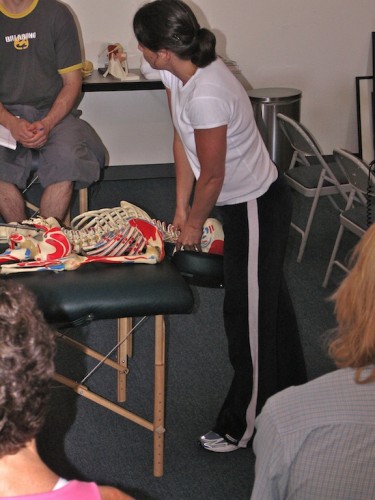
You’ll love Suzi. Not only is she beautiful, but she’s incredibly intelligent!
REHABILITATION
In the course, I share a LOT about how to use exercise to effectively restore optimal shoulder function. I cover most all the commonly used exercises and show how faulty technique can, and often does damage the shoulder/neck complex.
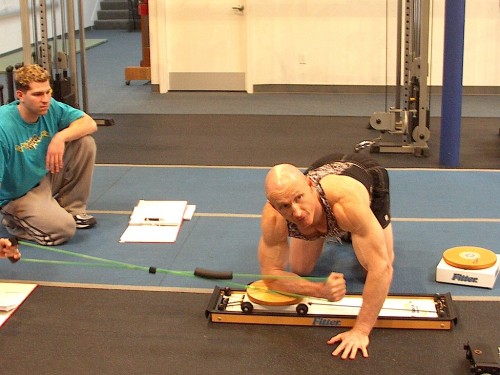
Here you can see me demonstrating a technique I developed when I owned my physical therapy clinic with my partner, Steve Clark, MS, OPT, SPT.
Steve was an expert on both shoulder and knee injuries, while my specialty was spinal pathology and chronic pain.
I was fortunate to work with Steve for many years, which allowed me to learn a lot from him and other experts along the way.
In this photo, I’m teaching my students in CHEK Level 3 how to combine closed chain exercise to stabilize the injured shoulder joint with open chain movements at the same time.
This is a nifty trick that’s allowed me to help many who’d been written off as athletes by the medical community. In this program, I share many such “nifty” methods.
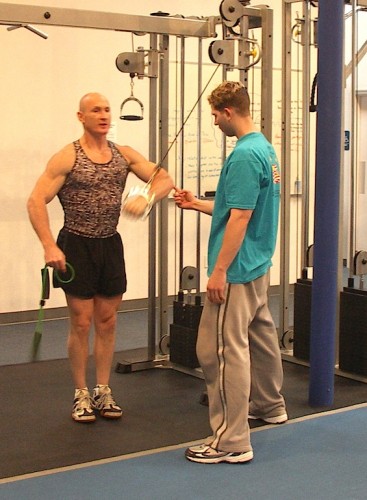
Here you can see me teaching the importance of keeping the rotational axis stable when performing rotator cuff rehab or prevention exercises.
Most therapists and trainers are quite unaware of the importance of axis management while prescribing exercises. If the axis isn’t effectively managed as I teach, the client will develop substitution patterns.
When this occurs, people do get stronger, but they do it by training the wrong muscles. That allows them to continue lifting and exercising incorrectly, which often results in re-injury!
I show you how to avoid re-injury and create long-term strength and conditioning.
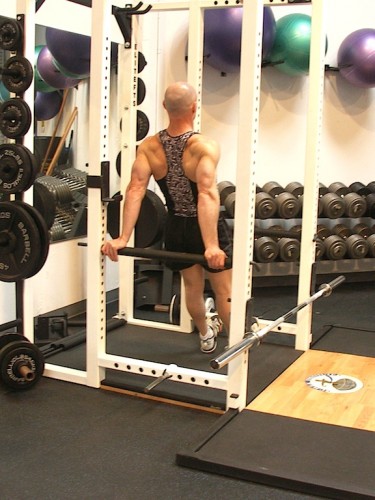
Here you can see me teaching an exercise I developed for conditioning the lower trapezius group.
The lower trapezius muscles are important shoulder stabilizes that commonly weaken in response to tightness in the pectoralis minor and major.
Being classified as phasic muscles (more likely to lengthen and weaken with faulty loading), these muscles often need preventative conditioning as part of an exercise program to keep the shoulder balanced and healthy.
In Scientific Shoulder Training, I show many such exercises and how to use them.
Bench Pressing Injuries and Common Shoulder Pathology

Here you can see me teaching how to assess the push pattern to a group of trainers, physios, and Naturopaths in Sweden.
Most people are quite stunned to find out how deficient the stabilizer systems are, even among the most well conditioned athletes.
In Scientific Shoulder Training, I show many functional assessments that allow you to identify faulty motor patterns and correct them.
I’ve taught these methods to professional sports teams, Olympic team coaches, trainers and therapists and elite Olympic lifting coaches around the world and have had only positive feedback from them!because the methods I teach actually work!
I don’t teach things in my courses that I haven’t tried and tested extensively enough to feel very safe sharing them.
After 28 years in this business, I’ve had plenty of time to learn, create and test many methods as you can imagine.
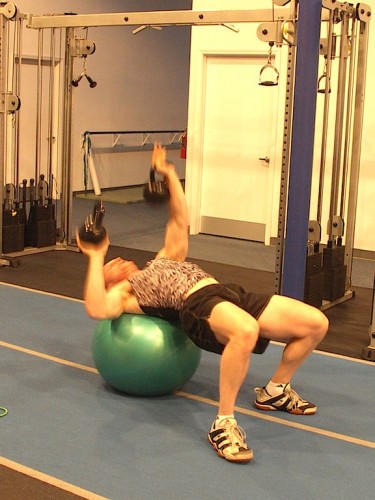
Here you can see me demonstrating safe and effective methods for rehabilitating the shoulder from anterior capsular laxity, which is the most common shoulder injury in the gym, and athletics in general.
Years ago, I developed specialized methods for using a Swiss ball to restrict shoulder range of motion as well as integrate the rest of the core and body into the training so that the muscle systems learn to integrate more effectively.
In Scientific Shoulder Training, you will learn many useful tips to get athletes back in top form again.

Here I’m teaching my students how to perform the Overhead Press Shrug.
I developed this exercise years ago because I had a number of injured workers, such as painters, finish carpenters, dry wallers, brick layers, and electricians that have to do a lot of overhead work, yet got injured due to weakness in the scapular elevators.
Scientific Shoulder Training will offer a wide variety of exercises, allowing you a great toolbox of options you can use for about anyone wanting optimal performance and injury prevention.
WRIST STRAP DANGERS!
Though many athletes and gym goers tend to love using wrist straps because they allow then to lift heavier weights than they can without them, as a therapist, I’ve seen many injuries to the neck, shoulder, wrist and back occur because of them.
What people don’t realize is that your grip regulates stabilizer recruitment in our body. This occurs through the process of irradiation or neurological “overflow”.
The harder you must grip any object to lift it, the more excitation you generate in the motor neuron pools that activate the grip muscles.
As excitation in the central nervous system elevates, the neurons “overflow” into adjacent spinal segments, exciting the neurons there, which results in elevated tone and readiness in all muscles being excited by the pattern your nervous system is generating for a given life.
When you wear wrist straps, I estimate that your grip muscles reduce in neural drive or activity by as much as 30%-50%, which results in the body thinking that the load you are lifting is that much lighter respectively, and therefore, stabilizer recruitment is down-regulated relative to what would be needed to safely lift a load without wrist straps.
In Scientific Shoulder Training, I explain the details and encourage people to simply learn to train properly instead of using cheat methods that ultimately only produce strength you can use when you are wearing your straps and other little toys; if you gym training isn’t effective outside the gym, is it really effective for anything other than bolstering your ego?
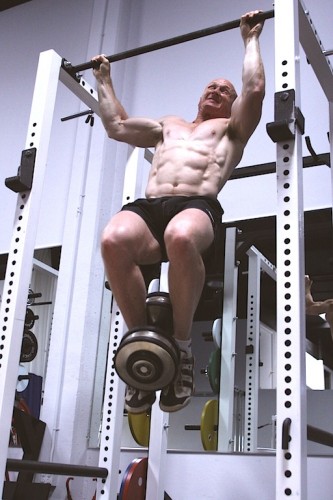
Here you can see me performing rock climber chin-ups with a heavy dumbbell.
Rock Climber chin-ups are very challenging; you bring your forehead to the back of one hand, and then on the next rep, you bring your head to the other hand and alternate with each rep.
This requires much more strength and dynamic control than most chin-ups people perform in the gym.
When I was in heavy training, I could do sets of 10 with 70 pounds, without any aid of wrist straps and my best is 42 consecutive rock climber chins with body weight. I did that when I was 42, which was my goal at that time.
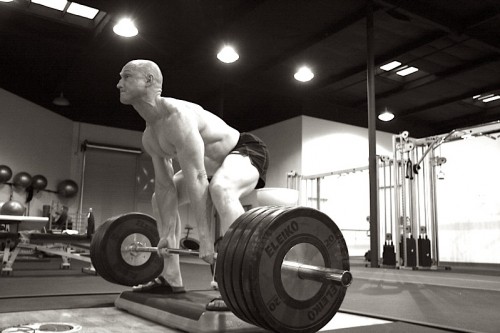
In the deadlift photo above, I’m pulling reps with 405 off the box. Notice again, no straps, suits, wraps, props, pills or powders! Just me and my Birkenstocks!
When I’m training heavy, I regularly pull 465 off the box and have been able to get 10 sets of 2-4 with 500 pounds in the deadlift, again, all raw.
Even today at 50 years of age and 168 pounds of body weight, I’m able to pull reps with 405 off the box using the natural training methods I teach in Scientific Shoulder Training and all my courses.
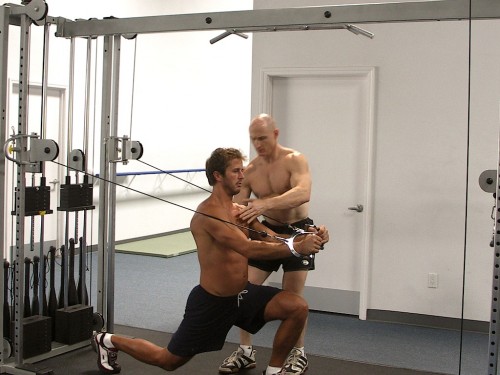
Here you can see me teaching famous hockey star Mike Modano how to perform a bilateral cable push.
In Scientific Shoulder Training, you will learn many new and useful exercises for conditioning yourself, amateur or professional athletes at any stage of development.
ADDITIONALLY
In my new Scientific Shoulder Training program, you will learn:
– What organs can cause reflex dysfunction in the shoulder complex
– Which biological control systems in your body have influence over the shoulder and how shoulder pain is often a symptom of problems elsewhere in your body.
– How the muscle chains work in the body and how they interact with the shoulder.
– What the selective pressures of nature were that influenced the developmental anatomy of the shoulder and how that understanding can change your clinical approach to shoulder conditioning and rehabilitation.
– Numerous practical functional assessment techniques for the shoulder complex, and much more!
I hope you’ve enjoyed seeing some of the exercises I have developed, use and teach my students and learning about the many new and useful methods available to you in my new Scientific Shoulder Training correspondence course.
Again, feel free to visit: The C.H.E.K Institute and fill out the short form so we can notify you of our early-bird purchase offer.
Well, that’s it for today!
I hope you make it a great one!
Love and chi,
Paul Chek






